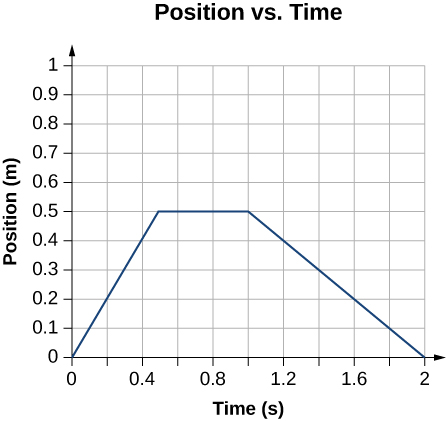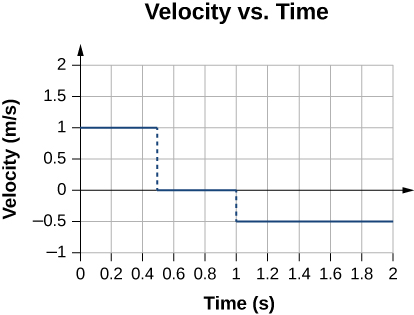| << Chapter < Page | Chapter >> Page > |

Time interval 0.5 s to 1.0 s:
Time interval 1.0 s to 2.0 s:
The graph of these values of velocity versus time is shown in [link] .

In everyday language, most people use the terms speed and velocity interchangeably. In physics, however, they do not have the same meaning and are distinct concepts. One major difference is that speed has no direction; that is, speed is a scalar.
We can calculate the average speed by finding the total distance traveled divided by the elapsed time:
Average speed is not necessarily the same as the magnitude of the average velocity, which is found by dividing the magnitude of the total displacement by the elapsed time. For example, if a trip starts and ends at the same location, the total displacement is zero, and therefore the average velocity is zero. The average speed, however, is not zero, because the total distance traveled is greater than zero. If we take a road trip of 300 km and need to be at our destination at a certain time, then we would be interested in our average speed.
However, we can calculate the instantaneous speed from the magnitude of the instantaneous velocity:
If a particle is moving along the x -axis at +7.0 m/s and another particle is moving along the same axis at −7.0 m/s, they have different velocities, but both have the same speed of 7.0 m/s. Some typical speeds are shown in the following table.
| Speed | m/s | mi/h |
|---|---|---|
| Continental drift | ||
| Brisk walk | 1.7 | 3.9 |
| Cyclist | 4.4 | 10 |
| Sprint runner | 12.2 | 27 |
| Rural speed limit | 24.6 | 56 |
| Official land speed record | 341.1 | 763 |
| Speed of sound at sea level | 343 | 768 |
| Space shuttle on reentry | 7800 | 17,500 |
| Escape velocity of Earth* | 11,200 | 25,000 |
| Orbital speed of Earth around the Sun | 29,783 | 66,623 |
| Speed of light in a vacuum | 299,792,458 | 670,616,629 |

Notification Switch
Would you like to follow the 'University physics volume 1' conversation and receive update notifications?